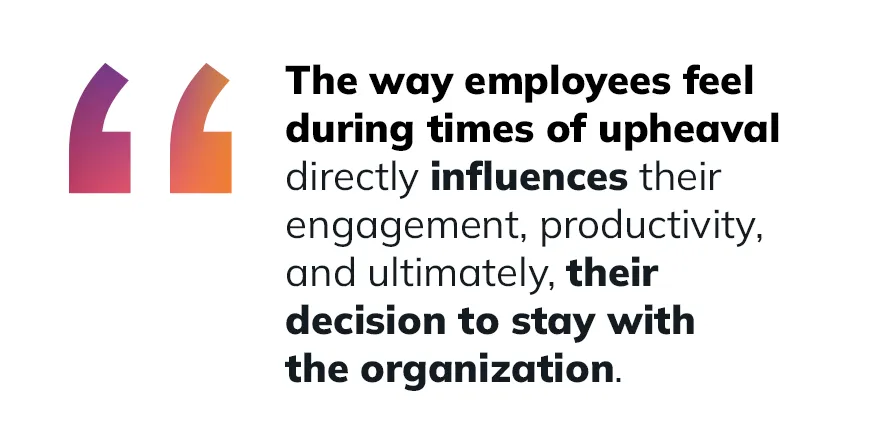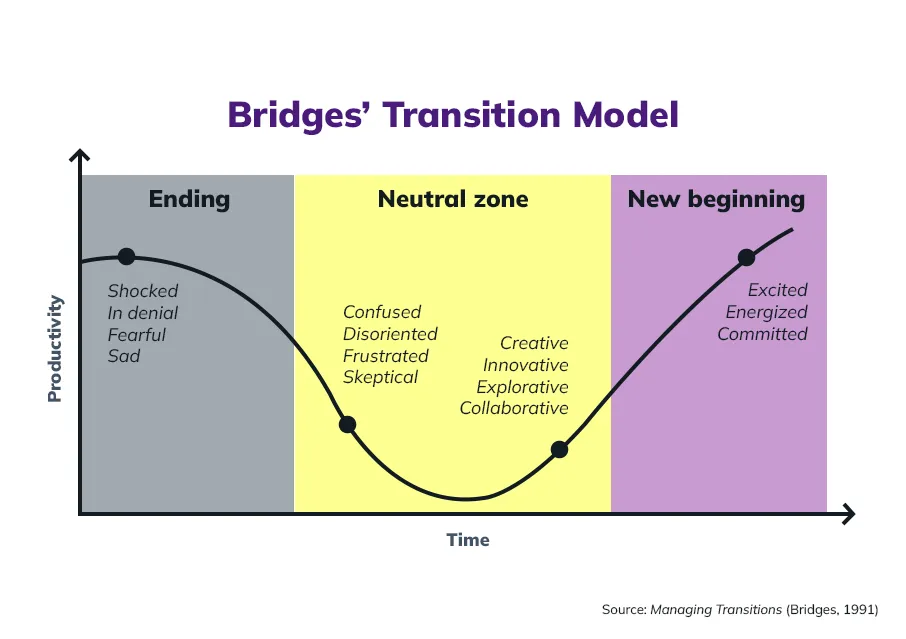
Organizational change is no longer an occasional disruption; it’s a near-constant state for many businesses. Though the exact figures vary, numerous studies indicate that a substantial portion of organizational change efforts fall short of their goals, often due to insufficient attention to the human side of change.Having witnessed many change initiatives firsthand, the truth of that statistic really hits home. The best-laid plans can unravel if we don’t acknowledge the very real feelings of the people going through it.This is the first article in a three-part series designed to provide L&D professionals with actionable strategies and frameworks to effectively support employees and leadership through organizational change. These transitions, whether driven by technological advancements, market shifts, or strategic realignments, profoundly impact employees, creating a ripple effect that can either propel the organization forward or lead to significant setbacks. Recognizing and addressing the emotional responses to change isn’t just a “nice-to-have;” it’s a fundamental pillar of successful change management.

Ignoring these emotions can breed resistance, fuel anxiety, increase absenteeism, and drive valuable talent away. For L&D professionals, understanding this emotional landscape is the first critical step in becoming effective change agents and strategic thought partners with leaders of your organization.
To navigate this complex terrain, L&D professionals can leverage established frameworks like the Kübler-Ross Change Curve and Bridges' Transition Model. These models provide valuable insights into the typical emotional responses and psychological transitions individuals may experience.

The Kübler-Ross Change Curve may look familiar because it was initially developed to understand the stages of grief. However, it also offers valuable insights into how individuals process significant change.As illustrated in the chart, employees may initially experience shock or denial as the news of a change sinks in. These feelings can then give way to frustration and even depression as the reality of the change and its implications become clearer. Over time, individuals may begin to experiment with new ways of working, eventually leading to a decision to accept the change and finally integrate it into their routines.Let’s explore how this might look in an organization: Upon hearing the layoff news at his company, Mark was shocked by the scale of impact on his colleagues. Initially, he felt denial, struggling to accept the departure of so many friends. His denial soon turned to frustration and a sense of injustice for those affected. A period of depression followed as the workplace dynamic shifted and he felt the loss of camaraderie.Later, Mark began to experiment, considering how to adapt and support the remaining team. He made a decision to actively contribute to the new structure, eventually leading to integration as he adjusted to the changed environment.Bridges’ Transition Model complements our understanding of this process with a focus on psychological transitions.

According to Bridges’ model, the process begins with Ending, during which employees grapple with what they are leaving behind. These emotions are followed by the Neutral Zone, a period of uncertainty and confusion as the old ways fade and the new aren’t fully established. Finally, individuals move into the New Beginning, characterized by acceptance, energy, and a sense of purpose in the new reality.Let’s revisit Mark’s experience through the lens of the Bridges model.The news of the layoffs marked the Ending phase for Mark. Even though his job was safe, he experienced the loss of his close colleagues, the disruption of familiar team dynamics, and uncertainty about the future of the company. He was forced to let go of the way things used to be.This letting-go period was followed by the Neutral Zone. Mark felt a sense of limbo as the old structure dissolved and the new one hadn’t fully formed. There was general confusion about new roles, responsibilities, and the overall direction. Mark may have felt unmoored and less productive during this in-between time.Finally, as the company began to stabilize and new ways of working emerged, Mark entered the New Beginning. He started to adapt to the reshaped teams, understand his evolving role, and find a new sense of purpose within the changed organization. Though he still felt the losses, he began to embrace the future and contribute to the new normal.Though the Kübler-Ross Curve and Bridges' Transition Model aren't perfect predictors of individual experiences, they provide a valuable map—and a way for us as L&D professionals to anticipate the emotional terrain our employees might be navigating.
By understanding the profound emotional impact of organizational change, L&D professionals are strategically positioned to partner with leadership. As we anticipate typical employee reactions across the emotional stages of transition, we can proactively develop targeted support mechanisms. This foresight not only minimizes disruption and fosters a more positive employee experience; it also directly supports the organization’s strategic objectives for successful change adoption. The following examples illustrate this alignment:
By proactively addressing the emotional needs of employees throughout these stages, L&D provides critical insights to leadership, acting as a strategic thought partner in change management. This partnership allows for the development of targeted interventions that support employee well-being, foster a more positive transition, and directly contribute to key organizational objectives. By targeting outcomes such as maintaining morale and productivity, reducing resistance that can derail initiatives, and preventing costly negative outcomes like increased absenteeism and turnover, a data-driven, employee-centric approach strengthens leadership’s ability to navigate change effectively and achieve desired business results.
Empathy is not just a “soft skill;” it’s a crucial foundation enabling L&D professionals to be effective strategic thought partners during organizational change. By understanding and acknowledging the emotional experiences of employees, L&D gains critical insights into the true impact of change initiatives. This empathetic lens allows us to build trust with employees and leadership in equal measures, fostering the open communication channels vital to the success of any transition. This lens empowers us to design more effective and targeted support strategies that resonate with employee needs and align with the organization's strategic goals for change adoption.Here are some practical ways L&D can strategically demonstrate empathy:
Organizational change, while often driven by strategic imperatives, unfolds within a complex emotional landscape. By applying frameworks like the Kübler-Ross Change Curve and Bridges' Transition Model, L&D professionals can gain invaluable insights into the emotional responses that can either hinder or facilitate successful transitions.As always, empathy serves as the cornerstone of L&D’s strategic contribution. It's through our deep understanding of the employee experience that L&D can proactively develop targeted support strategies, build crucial trust across the organization, and provide leadership with the nuanced perspectives needed to navigate change effectively. Our empathetic and data-informed approach positions L&D as a vital strategic partner in ensuring that organizational changes are not only implemented but also valued and embraced by our people, leading to more positive and sustainable outcomes.To help you further evaluate your readiness to support employees through these emotional stages, we encourage you to download the Self-Assessment Tool.In the second installment of our Leading Through Organizational Change series, we will delve into the power of training and communication as critical change management tools and demonstrate how L&D can strategically leverage them to equip employees with the skills and information they need to adapt to change successfully. Our third installment will zoom in on how L&D can empower managers to lead their teams through change with a crucial blend of strategic insight and empathy.Is your organization facing a change management challenge all on its own? Reach out to chat about opportunities to drive business growth and support your leadership, managers, and teams with our proven strategic consulting approach to change management.
Looking for more on how L&D leaders and teams can support leaders, managers, and employees through change initiatives? Check out these related articles in our Leading Through Organizational Change series: